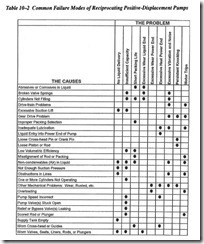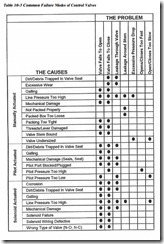FAILURE MODES OF HYDRAULIC COMPONENTS
Each of the components that make up a hydraulic circuit has inherent strengths and weaknesses. These design characteristics define the more common failure modes that may effect each of these components.
Positive-Displacement Pumps
Most hydraulic pumps are positive displacement and are more tolerant to variations in system demands and pressures than centrifugal pumps. However, they are still subject to a variety of common failure modes caused directly or indirectly by the process.
Rotary- Type
Rotary-type, positive-displacement pumps share many common failure modes with centrifugal pumps. Both types of pumps are subject to process-induced failures caused by demands that exceed the pump’s capabilities. Operating methods that result in either radical changes in their operating envelope or instability in the process sys tem also cause process-induced failures.
Table 10-1 lists common failure modes for rotary-type, positive-displacement pumps. The most common failure modes of these pumps are generally attributed to problems with the suction supply. They must have a constant volume of clean liquid in order to function properly.
Reciprocating
Table 10-2 lists the common failure modes for reciprocating-type positive-displace ment pumps. Reciprocating pumps can generally withstand more abuse and variations in system demand than any other type. However, they must have a consistent supply of relatively clean liquid in order to function properly.
The weak links in the reciprocating pump’s design are the inlet and discharge valves used to control pumping action. These valves are the most frequent source of failure. In most cases, valve failure is due to fatigue. The only positive way to prevent or min imize these failures is to ensure that proper maintenance is performed regularly on these components. It is important to follow the manufacturer ‘s recommendations for valve maintenance and replacement.
Because of the close tolerances between the pistons and the cylinder walls, reciprocat ing pumps cannot tolerate contaminated liquid in their suction-supply system. Many of the failure modes associated with this type of pump are caused by contamination (e.g., dirt, grit, and other solids) that enters the suction side of the pump. This problem can be prevented by the use of well-maintained inlet strainers or filters.
Control Valves
Although there are limited common control valv.e failure modes, the dominant prob lems are usually related to leakage, speed of operation , or complete valve failure. Table 10-3 lists the more common causes of these failures.
Special attention should be given to the valve actuator when conducting a Root Cause Failure Analysis . Many of the problems associated with both process and fluid-power control valves are really actuator problems.
In particular, remotely controlled valves that use pneumatic, hydraulic, or electrical actuators are subject to actuator failure. In many cases, these failures are the reason a valve fails to properly open, close, or seal. Even with manually controlled valves, the true root cause can be traced to an actuator problem. For example, when a manually operated process-control valve is jammed open or closed, it may cause failure of the valve mechanism. This overtorquing of the valve’s. sealing device may cause damage or failure of the seal, or it may freeze the valve stem. Either of these failure modes results in total valve failure.
Incoming search terms:
- hydraulic actuator failure modes
- common failure modes of hydraulic control systems
- failure modes of hydraulic systems
- failure modes of positive displacement pump


